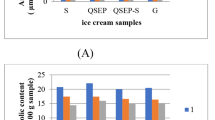Abstract
In the present study, the effects of derivatives of cassava, maltodextrin and bagasse, on the physicochemical, physical and sensory properties of ice creams were investigated. The content of cassava maltodextrin increased significantly the content of carbohydrate and total soluble solids and decreased lipids content. The effect of cassava bagasse was more pronounced than the maltodextrin on physical and sensory parameters. Increased percentage of cassava bagasse in formulation led to decrease of overrun, melting and luminosity, but increased hardness and unfreezable water. Sensory attributes were mainly influenced by cassava bagasse inclusion. The results suggested the potential use of cassava derivatives in ice cream formulations. Ice creams with low percentage of cassava bagasse (1.5) and intermediate values of cassava maltodextrin (3.65%) had good nutritional, technological and sensorial acceptance.




Similar content being viewed by others
References
ABIS Associação Brasileira das Indústrias e do Setor de Sorvetes (2016) Produção e consumo de Sorvetes no Brasil. http://www.abis.com.br/estatistica_producaoeconsumodesorvetesnobrasil.html. Accessed 14 Oct 2016
Aboulfazli F, Shori AB, Baba AS (2016) Effects of the replacement of cow milk with vegetable milk on probiotics and nutritional profile of fermented ice cream. LWT Food Sci Technol 70:261–270
Adapa S, Schmidt KA, Jeon JJ, Herald TJ, Flores RA (2000) Mechanisms of ice crystallization and recrystallization in ice cream: a review. Food Rev Int 16:259–271
Akalin AS, Karagözlü C, Ünal G (2008) Rheological properties of reduced-fat and low-fat ice cream containing whey protein isolate and inulin. Eur Food Res Technol 227(3):889–895
Alvarez VB, Wholters CL, Vodovotz Y (2005) Physical properties of ice cream containing milk protein concentrates. J Dairy Sci 88(3):862–871
AOAC (2005) Official methods of analysis, (18th edn). Association of Official Analytical Chemists, Gaithersburg, Maryland 20877-2417, USA
Bech-Larsen T, Grunert KG (2003) The perceived healthiness of functional foods. A conjoint analysis of Danish, Finnish and American consumers’ perception of functional foods. Appetite 40:9–14
Boff CC, Crizel TM, Araujo RR, Rios AO, Flores SH (2013) Development of chocolate ice cream using orange peel fiber as fat replacer. Cienc Rural 43(10):1892–1897
Cadena RS, Bolini HMA (2011) Time-intensity analysis and acceptance test for traditional and light vanilla ice cream. Food Res Int 44(3):677–683
Cogné C, Laurent P, Andrieu J, Ferrand J (2003) Experimental data and modelling of ice cream freezing. Chem Eng Res Des 81(9):1129–1135
Crizel TM, Araujo RR, Rios AO, Rech R, Flôres SH (2014) Orange fiber as a novel fat replacer in lemon ice cream. Food Sci Technol 34(2):332–340
Cruz AG, Antunes AEC, Sousa ALOP, Faria JAF, Saad SMI (2009) Ice cream as a probiotic food carrier. Food Res Int 42(9):1233–1239
Dervisoglu M, Yazici F (2006) Note. The effect of citrus fibre on the physical, chemical and sensory properties of ice cream. Food Sci Technol Int 12(2):159–164
El-Nagar G, Clowes G, Tudoricǎ CM, Kuri V, Brennan CS (2002) Rheological quality and stability of yog-ice cream with added inulin. Int J Dairy Technol 55:89–93
Fiorda FA, Soares Júnior MS, Silva FA, Souto LRF, Grossmann MVE (2013) Cassava bagasse flour: byproduct utilization and comparison with cassava starch. Pesquisa Agropecuaria Tropical 43(4):408–416
Goff HD (2002) Formation and stabilisation of structure in ice cream and related products. Curr Opin Colloid Interface Sci 7(5–6):432–437
Granger C, Leger A, Barey P, Langendorff V, Cansell M (2005) Influence of formulation on the structural networks in ice cream. Int Dairy J 15(3):255–262
Güzeler N, Ali Kaçar A, Say D (2011) Effect of milk powder, maltodextrin and polydextrose use on physical and sensory properties of low calorie ice cream during storage. Akademik Gıda 9(2):6–12
Hwang JY, Shyu YS, Hsu CK (2009) Grape wine lees improves the rheological and adds antioxidant properties to ice cream. LWT Food Sci Technol 42(3):12–18
Karaca OB, Güven M, Yasar K, Kaya S, Kahyaoglu T (2009) The functional, rheological and sensory characteristics of ice creams with various fat replacers. Int J Dairy Technol 62(1):93–99
Ludvigsen HK (2012) Manufacturing high quality ice cream with high overrun. Food Market Technol 1:4–7
Marshall RT, Goff HD, Hartel RW (2003) Ice cream. Kluwer Academic/Plenum Plublishers, New York
Meilgaard M, Civille GV, Carr BT (1999) Sensory evaluation techniques. CRC, New York
Mintel (2016) Global ice cream market 2016. http://www.mintel.com. Accessed 14 Oct 2016
Muse MR, Hartel RW (2004) Ice cream structural elements that affect melting rate and hardness. J Dairy Sci 87(1):1–10
Pinheiro MVS, Penna ALB (2004) Substitutos de gordura: Tipos e aplicações em produtos lácteos. Alim Nutr 15(2):175–186
Rodríguez R, Jiménez A, Fernández-Bolaños J, Guillén R, Heredia A (2006) Dietary fibre from vegetable products as source of functional ingredients. Trends Food Sci Technol 17:3–15
Roland A, Phillips LG, Boor KJ (1999) Effects of fat replacers on the sensory properties, color, melting, and hardness of ice cream. J Dairy Sci 82:2094–2100
Rossa PN, Burin VM, Bordignon-Luiz MT (2012) Effect of microbial transglutaminase on functional and rheological properties of ice cream with different fat contents. LWT Food Sci Technol 48(2):224–230
Salem MM, Fathi FA, Awad R (2005) Production of probiotic ice cream. Pol J Food Nutr Sci 14:267–271
Silva VM, Minim VPR, Ferreira MAM, Souza PHP, Moraes LES, Minim LA (2014) Study of the perception of consumers in relation to different ice cream concepts. Food Qual Preference 36:161–168
Sonwane RS, Hembade AS (2014) Sensorial quality of dietetic soft serve ice-cream prepared by using different proportions of maltodextrin. Int J Curr Res Acad Rev 2(6):51–55
Soukoulis C, Chandrinos I, Tzia C (2008) Study of the functionality of selected hydrocolloids and their blends with k carrageenan on storage quality of vanilla ice cream. LWT Food Sci Technol 41(10):1816–1827
Trombini FRM, Leonel M, Mischan MM (2013) Development of extruded snacks from blends of soya flour, cassava starch and bran. Cienc Rural 43(1):178–184
Author information
Authors and Affiliations
Corresponding author
Rights and permissions
About this article
Cite this article
de Souza Fernandes, D., Leonel, M., Del Bem, M.S. et al. Cassava derivatives in ice cream formulations: effects on physicochemical, physical and sensory properties. J Food Sci Technol 54, 1357–1367 (2017). https://doi.org/10.1007/s13197-017-2533-8
Revised:
Accepted:
Published:
Issue Date:
DOI: https://doi.org/10.1007/s13197-017-2533-8




